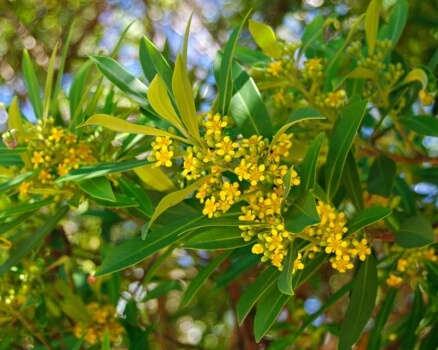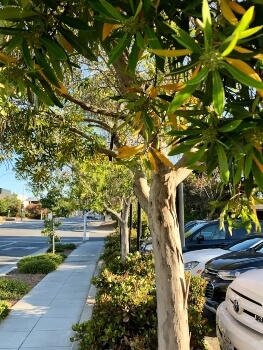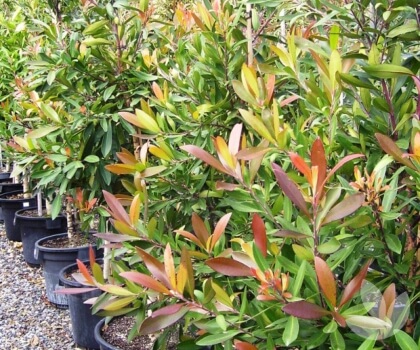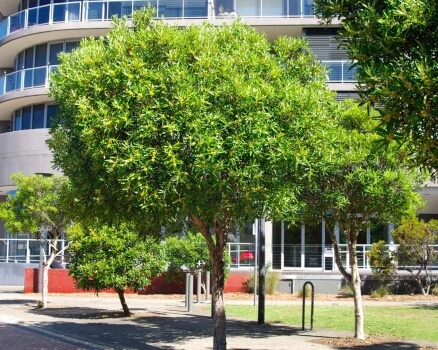Tristaniopsis laurina is a popular ornamental tree and is equally at home in a garden, or for landscaping purposes. The tree provides plenty of shade, and perhaps that’s why they line many streets in Sydney for example.
In our how to grow and care guide, we’ll officially introduce the Tristaniopsis laurina to you, go through how to care for your beautiful tree, how to propagate from seed and cuttings, pests and diseases to look out for.
More...
Family: | Myrtaceae |
|---|---|
Genus: | Tristaniopsis |
Species: | T. laurina |
Common Names: | Water Gum, Kanooka |
Location: | Outdoor |
Type: | Shrub or tree |
Growth: | Up to 15 metres tall, Up to 6 metres wide |
Sun requirements: | Full sun, partial shade |
Foliage Colour: | Dark green |
Flower Colour: | Yellow |
Flowering: | Summer, Spring |
Fruit: | None |
Maintenance level: | Low |
Poisonous for pets: | No |
Introducing Tristaniopsis laurina

Source: gardensonline.com.au
Tristaniopsis laurina is more commonly known as the Water Gum or Kanooka. Depending on its size, it can either be a big shrub or otherwise a small tree. The height range is between 5 and 15 metres and it can spread between 3 and 6 metres.
The bright flowers that arrive in the summertime are the most eye-catching part of the tree. The Water Gum is often used to line along streets but also makes a great screen if you are looking for a living wall to create privacy.
To top off the list of great qualities of the Kanooka, the tree is low maintenance too.
Tristaniopsis laurina Water Gum Plant Features
The Water Gum is very useful to nature and to humans – it’s the perfect feature plant but is also a windbreak. It helps with erosion control, and birds find it a great place for a nest.
Tristaniopsis laurina is also not affected by pollution. The tree attracts bees, birds (who have an absolute feast with the nectar), and butterflies.
How to Grow and Care for Tristaniopsis laurina in Australia

Source: trees.stanford.edu
Tristaniopsis laurina is happy with most types of soils and enjoys a fair amount of watering. While the tree doesn’t mind shade, it’s more of a sun worshipper.
You can easily keep the Water Gum in shape with a little bit of pruning. This tree is a great choice if you have a low maintenance garden. It does well in a coastal garden as it is salt tolerant and it’s resistant to drought.
Sunlight Preference
Make sure your tree has a position in full sun for ideal health and happiness. If you must, part shade is also fine.
Best Soil for Water Gum
The Water Gum, true to its low maintenance nature, can do with a whole range of soil types. The tree can do dry, well-drained or somewhere in-between.
That means that a rocky soil or a heavy clay loam soil are both fair game. In terms of pH level, acidic or neutral will do.
Climate
Tristaniopsis laurina grows well in a sub-tropical climate, as well as warm and cool temperature and also Mediterranean. The Kanooka is quite the feisty tree, being able to handle frost and drought like a pro.
Fertiliser
You can fertilise your Tristaniopsis laurina during the spring with a slow release native plant fertiliser. Need some help choosing the right fertiliser?
Have a look at our Yates fertiliser reviews and buying guide for 2024.
Watering Schedule
The Kanooka will need water every day for about 13 weeks until the plant has had a chance to become established. It does become drought tolerant when it’s older but in the early days, doesn’t do well with very dry conditions.
Adding mulch to your tree and garden always helps to lock in moisture.
Pruning Water Gum
The Water Gum responds very well to pruning. We recommend getting rid of any branches on the tree that are diseased, especially on a young tree.
The rest of the pruning would really be just to keep the desired shape that you want. It’s best to do your pruning once the flowers have bloomed for the season.
How to Propagate Tristaniopsis laurina

Source: specialitytrees.com.au
Growing Kanooka from seeds
If you are using seeds as your propagation method, be aware that it takes about four weeks for germination to take place. We recommend that you collect the seeds you are going to use during Autumn as they are still green.
You can then place the seeds in the sun to dry out and open up. You don’t need to pre-treat the seed in any way before sowing. When you are ready to sow the seeds, you want to use a loose and well-draining mixture.
Use the diameter of the seed as a guideline in terms of how deep you should plant it. When the seedling is around 2cm in height, you can move them to a bigger container, and then transplant in the garden when they are the right size.
Water Gum Propagation from Cutting
When choosing your cutting, you need to take a stem with some new growth. The older ones might struggle to produce roots. Late in the summertime is ideal for taking your cutting.
You want to ensure it has between 4 and 8 leaves on it, and length wise it should be around 12 centimetres. Use a sharp implement like pruning shears to make the cut just underneath a leaf node.
You can prepare a planting mixture that is about 3 parts of composted tree bark and 1 part perlite. Add in a dash of slow-release fertiliser.
Once you’ve placed the planting mixture into your desired pot or container, you can then water it well and mix the water through as you don’t want any dryness.
When planting your cuttings (if you are planting more than one), you should space them around 7.5cm apart. We know that the right soil makes all the difference!
Have a look at our buying guide for the best soil for pots in Australia to make sure your garden gets the very best.

Source: gardensonline.com.au
Next, you’ll need to remove the leaves on the bottom of the cutting and you’re going to need a rooting hormone, if possible, one with a fungicide.
If your rooting hormone doesn’t have, you can first dip the cuttings into a fungicide, let them dry, and then dip into a rooting hormone before planting in the growing mixture you have prepared. You can press down the soil around each cutting to make sure it’s compacted and firm.
Once this is done, cover the container and cutting with plastic then put it somewhere with bright light but not in direct sunlight. If you can place it in a spot with a temperature around 20°C, that is ideal.
You can mist the cuttings to maintain moisture levels and if the soil feels dry, you can then water accordingly. It generally takes around 30 days for the cuttings to start growing roots.
If you want to check, you can do a gentle tug on each cutting to see if there is any resistance. Once you know your cuttings have roots, you can then take the plastic off.
You can now move your cuttings to a sunnier spot and allow the soil to dry out a bit between each watering session. We call this process hardening off. You can do it gradually over around 6 weeks.
Over this time, you can place the cuttings in a bit of shade during the day. After another 30 days, your cuttings will then be ready to plant into the garden.
Pests and Diseases that Affect Tristaniopsis laurina
Glasshouse leafhopper

Source: rhs.org.uk
You’ll notice a mottled patch on the surface of the leaves and sometimes they actually look like they have a nutrient deficiency. Any leaves that have been attacked by this pest will stay this changed colour but the new leaves that appear later should be back to normal.
Leafhoppers are really tiny – they are a light yellow colour and have grey marks on their bodies. They can actually jump off the leaves. The eggs are much easier to spot and are a white colour.
In terms of treating your tree, you can remove the eggs that you can see on the leaves with your hands. Diatomaceous earth can be sprinkled on leaves and around the tree which helps to show the pest who is in charge.
Find out more about Diatomaceous earth and why should you use it in your garden.
Soft scale
This scale insect likes to suck sap from your tree and you’ll notice that the leaves become sticky. The soft scale produces a type of honeydew that covers the leaf surface, and this can cause sooty mould if not treated.
You’ll be able to see the scale bumps on the underneath of the leaves and on the stems. Even when the scales are dead, they sometimes remain on the leaves.
When it comes to treatment, you can get rid of the pest using a gentle toothbrush or an earbud with a rubbing alcohol. You can follow up with an organic insecticide for good measure.
Tristaniopsis laurina Frequently Asked Questions

Source: en.wikipedia.org
What does Tristaniopsis laurina mean?
Tristan, relating to Jules M.C.Tristan who was a French botanist. Iopsis is a Greek word that means appearance. Laurina is from the Latin word laurus, which means a laurel or bay tree.
What is the wood of the Tristaniopsis laurina tree used for?
The wood of this tree has a close grain which makes it strong but lightweight. It’s used to make tool handles, wooden screws and golf club heads.
What are the popular cultivars of Tristaniopsis laurina?
The most popular cultivar is called ‘Luscious’ which has broad leaves, and another is ‘Hot Tips’, which has variegation on the leaves and new leaves are a brown to red colour.
Subscribe to our mailing list for tips for beginner and intermediate gardeners, product reviews for some of the most popular garden tools on the market, and links to resources which will help you to grow a better garden.
Wrapping Up Our Growing and Care Guide for Tristaniopsis laurina
Tristaniopsis laurina, more locally known as the water gum or kanooka, is a lovely native to Australia. You’ll find it in abundance along the eastern coastline and it especially loves stream banks. The trunks and branches are often shaped like the current direction of the water, a beautiful example of how nature shapes things.
For the Australian garden, you’ll get to enjoy bright yellow flowers that attract honeybees and also other native bee species. Bring on spring and summer! We’re giving Tristaniopsis laurina our green thumbs up.
Published on September 4, 2022 by Lorri Hopkins
Last Updated on February 25, 2024




